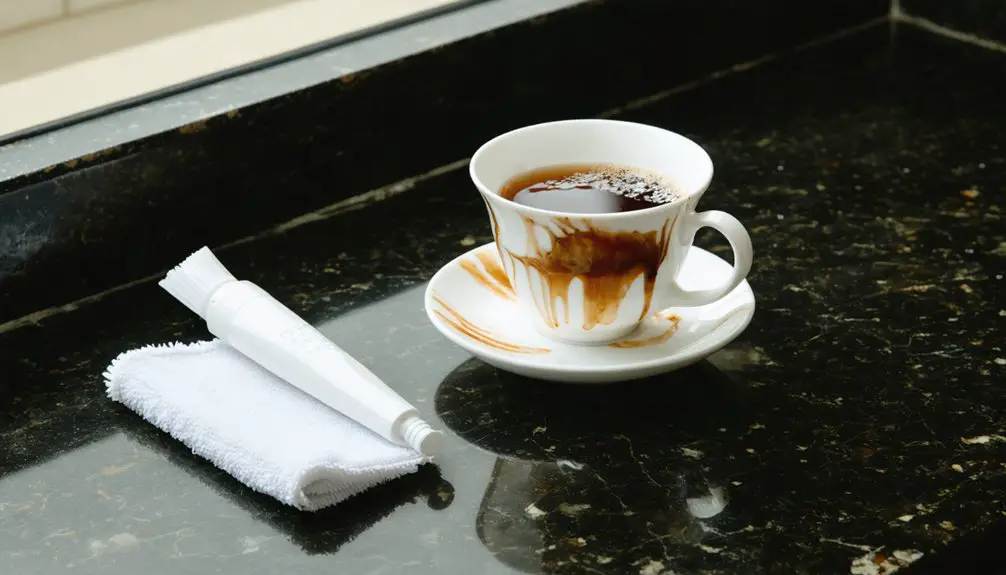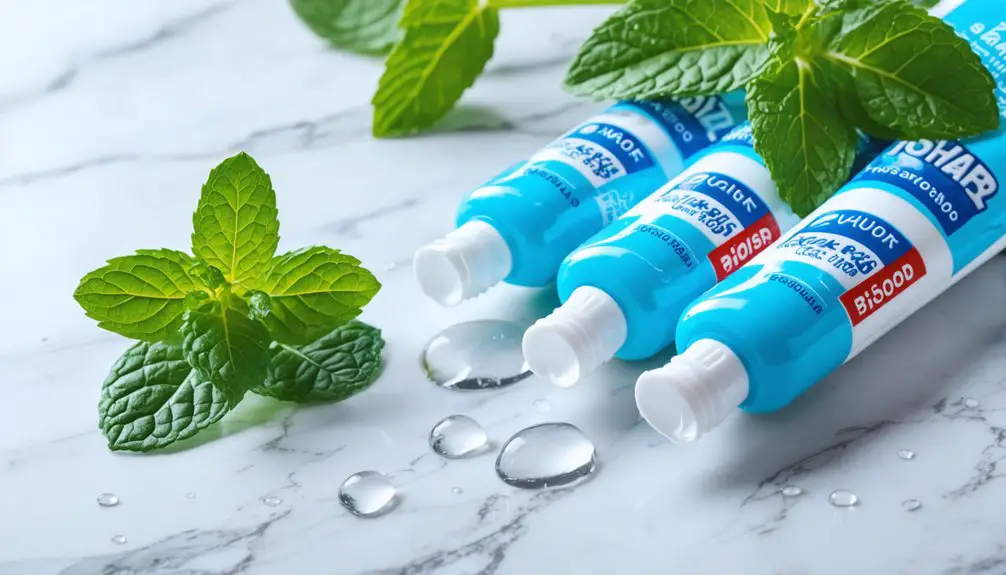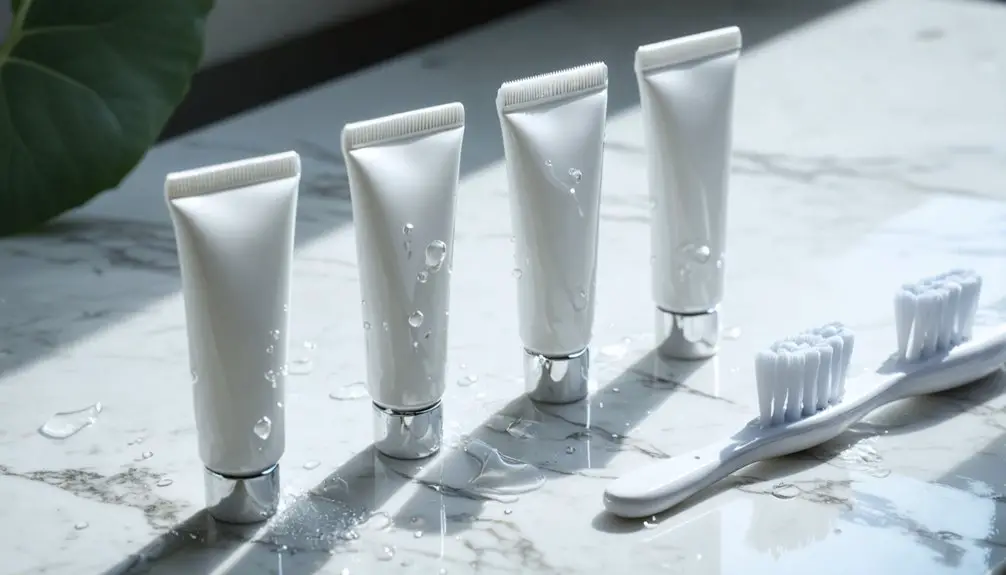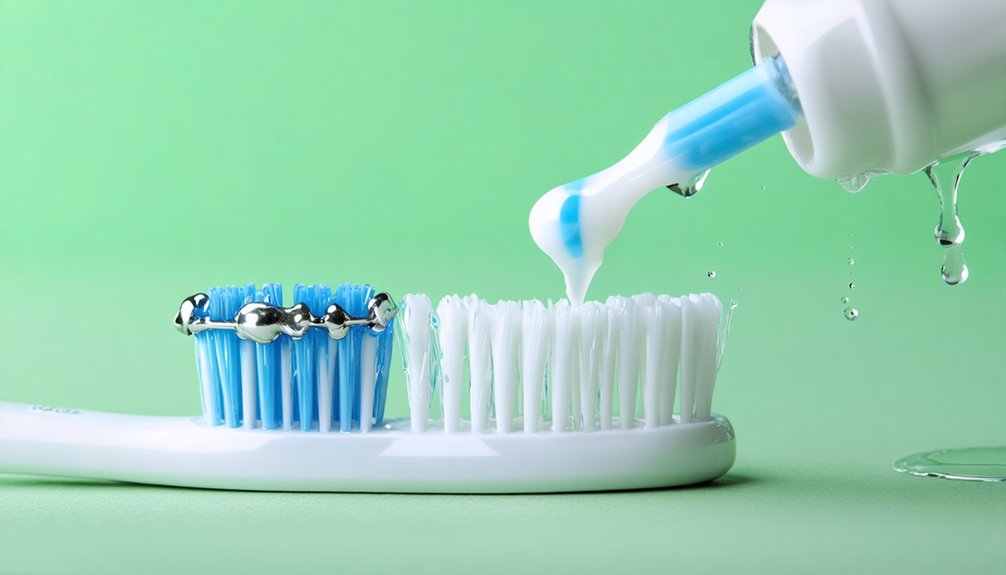You’ll effectively combat tea stains by selecting toothpaste containing hydrogen peroxide (5% concentration) and hydrated silica for ideal stain breakdown. Brush gently in circular motions at a 45-degree angle, focusing on tea-contact areas for two minutes twice daily. Use a soft-bristled brush and wait 30 minutes after tea consumption before brushing to protect enamel. Implementing specific techniques and product choices can dramatically enhance your stain-fighting results.
Key Takeaways
- Choose toothpaste containing hydrogen peroxide at 5% concentration and hydrated silica for effective tea stain removal.
- Use gentle circular motions with a soft-bristled brush at a 45-degree angle to safely remove stains.
- Wait 30 minutes after drinking tea before brushing, and rinse mouth immediately after consumption.
- Select whitening toothpaste with sodium hexametaphosphate to reduce tea staining by up to 90%.
- Brush twice daily for two minutes, focusing extra attention on front teeth where tea contact occurs most.
Choosing the Right Toothpaste for Tea Stain Removal
When selecting a toothpaste for tea stain removal, you’ll need to focus on formulations containing specific active ingredients that target tannin-based discoloration.
Look for products with hydrogen peroxide, particularly those offering 5% concentration, as this ingredient effectively breaks down stain molecules beneath the enamel surface. Using toothpaste with hydrated silica helps polish away surface stains effectively.
Consider toothpaste ingredients that combine stain prevention with gentle cleaning action. Opt for formulas containing antioxidants and natural extracts like green tea or cranberry, which help protect against future staining. Our featured toothpaste contains an innovative Elixir X blend that delivers powerful stain-fighting results.
For sensitive teeth, choose products with mild polishing agents such as mica or silica, and coconut-based surfactants instead of harsh sulfates.
If you’re concerned about enamel protection during whitening, select fluoride-containing options, though fluoride-free alternatives are available for those who prefer them.
Proper Brushing Techniques to Fight Tea Discoloration
Since tea stains accumulate gradually on tooth surfaces, implementing proper brushing techniques becomes essential for effective removal and prevention.
Regular, proper brushing techniques are crucial safeguards against the slow buildup of tea stains on your teeth.
You’ll achieve the best stain prevention by brushing with gentle circular motions at a 45-degree angle toward your gum line. Maintain a brushing frequency of twice daily, dedicating at least two minutes per session, with special attention to front teeth where tea contact is highest.
Don’t forget to include your tongue and palate in your brushing routine, as these surfaces can harbor pigments that contribute to discoloration.
While being thorough, avoid aggressive scrubbing that could damage your enamel. Instead, use controlled, elliptical strokes with a soft-bristled brush, ensuring you reach all tooth surfaces where tannins might accumulate. Using abrasive fruits like apples during snack time can naturally help scrub away surface stains. Consider using whitening toothpaste with baking soda for gradual stain removal during your daily brushing routine.
Daily Habits That Maximize Your Toothpaste’s Stain-Fighting Power
Beyond proper brushing techniques, your daily habits play a significant role in maximizing toothpaste’s stain-fighting capabilities. To optimize results, maintain a flossing frequency of twice daily to remove plaque and stain-causing biofilms from interdental spaces where toothpaste can’t reach.
Wait 30 minutes after consuming tea before brushing to protect your enamel. Using toothpaste containing sodium hexametaphosphate can reduce tea staining by up to 90%.
Consider dietary modifications that naturally support stain prevention. Incorporate crunchy fruits and vegetables into your diet, as they help scrub teeth surfaces. Use a straw when drinking tea to minimize contact with front teeth, and rinse your mouth with water immediately after consumption. Select toothpastes with hydrated silica abrasives for effective mechanical stain removal.
For enhanced protection, combine tartar-control toothpaste with these habits, as reducing calculus buildup prevents stain entrapment and simplifies cleaning.
Frequently Asked Questions
Can Tea Stains Permanently Damage Tooth Enamel Over Time?
While tea stains don’t directly damage tooth enamel, tea’s acidity can weaken it over time. You’ll need consistent stain prevention and good oral hygiene to protect your enamel’s integrity.
How Long Does It Take to See Visible Results From Toothpaste-Based Stain Removal?
You’ll notice toothpaste effectiveness in stain removal within 2-6 weeks of consistent twice-daily brushing. More significant results emerge after 12 weeks, though this varies based on your brushing habits.
Are Natural Tooth-Whitening Remedies Effective Against Stubborn Tea Stains?
Without 3-43% peroxide concentrations found in professional treatments, natural remedies won’t effectively remove stubborn tea stains. You’ll see better results preventing stains through tea alternatives and consistent oral hygiene practices.
Does the Temperature of Tea Affect How Severely It Stains Teeth?
You’ll experience more severe tooth staining when drinking cold or room temperature tea (4-23°C) compared to hot tea (37-50°C), as cooler temperatures enhance pigment adhesion to your teeth.
Can Professional Dental Cleaning Completely Eliminate Years-Old Tea Stains?
Time’s taken its toll – professional dental cleaning won’t completely remove years-old tea stains. While stain removal techniques target surface discoloration, deeper stains require additional treatments beyond standard dental hygiene.
References
- https://www.docklandsdental.ie/how-to-remove-tea-stains-from-teeth/
- https://pmc.ncbi.nlm.nih.gov/articles/PMC5727726/
- https://myemergencydental.com/how-do-you-suggest-removing-coffee-and-tea-stains-from-teeth/
- https://www.advantagedental.com/blog/how-to-remove-coffee-and-tea-stains-from-your-teeth
- https://www.dentalcare.com/en-us/ce-courses/ce565/stain-control-whitening
- https://www.colgate.com/en-sa/colgate-optic-white-lovers
- https://moonoralbeauty.com/products/stain-removal-whitening-toothpaste
- https://www.nogapsdental.com/blog/best-toothpaste-for-teeth-whitening/
- https://crest.com/en-us/oral-care-products/toothpaste/3d-white-stain-eraser-whitening-toothpaste-icy-clean
- https://www.boka.com/blogs/guides/remove-coffee-and-tea-stains-from-teeth



